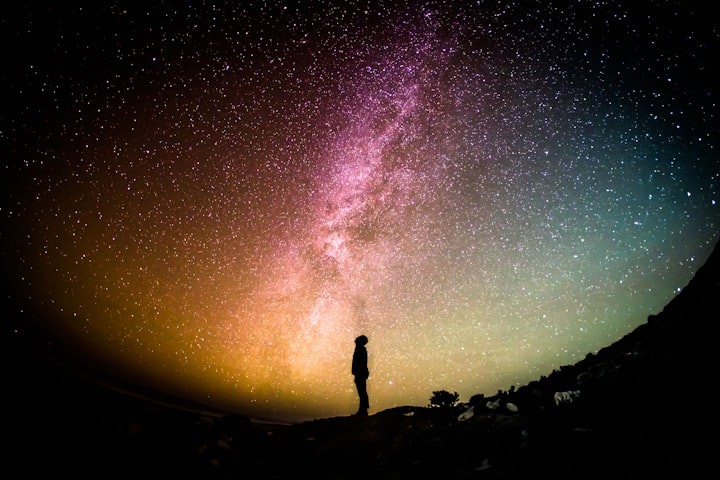The silence of the stars
In a not-so-distant future, humanity has reached the stars, colonizing planets and discovering countless new worlds teeming with life.

In the quiet solitude of a remote observatory, Dr. Maria Rodriguez, an astrophysicist with a deep passion for the cosmos, sat hunched over her computer screen. Night after night, she had scanned the heavens, searching for a sign—a whisper, a signal, any indication of life beyond our pale blue dot.
Maria's fascination with the stars had begun in her childhood. Growing up in a small town under pristine night skies, she had often gazed at the luminous tapestry above and wondered, "Are we alone?" That question had driven her to pursue a career in astrophysics.
The Fermi Paradox haunted her thoughts. It was the stark contrast between the high probability of intelligent extraterrestrial life in our galaxy and the eerie absence of contact. The paradox suggested that Earth should be teeming with radio signals and messages from advanced civilizations. Yet, all that met the ears of astronomers like Maria was silence.
She had dedicated her life to deciphering this cosmic enigma. Countless hours were spent analyzing data, attending international conferences, and collaborating with brilliant minds worldwide. Some of her peers had given up, deeming the search futile. But Maria's conviction remained unshaken.
One chilly autumn evening, as Maria observed a distant star cluster through her telescope, a faint glimmer caught her eye—a blip on her computer screen. Her heart raced as she adjusted the equipment to capture the signal. It was subtle, almost imperceptible, but it carried a pattern, a rhythm amidst the cosmic noise.
Excitement coursed through her veins as she worked tirelessly to decode the message. It was an intricate mathematical sequence, repeating and evolving like a cosmic heartbeat. A message from the great cosmic void.
Word spread rapidly, and the global scientific community rallied behind Maria's discovery. A wave of anticipation and wonder washed over the world. For the first time in human history, evidence of intelligent extraterrestrial life was within reach.
Months of collaborative effort yielded stunning results. The message, written in a universal language of mathematics, contained knowledge that transcended human comprehension. It spoke of advanced science, art, and philosophy—a repository of wisdom from an ancient and distant civilization.
As Maria stood before the world, sharing the astonishing findings, she became a symbol of humanity's enduring curiosity and resilience. The insights from the cosmic message propelled Earth into a new era of innovation and unity.
Yet, even as the world celebrated its newfound cosmic companions, Maria couldn't escape the haunting question: Why had the universe remained silent for so long? The ancient civilization that had sent the message had likely faded into obscurity eons ago.
In the end, the silence of the stars was a testament to the vastness of space and the limitations of technology. It was a reminder of the cosmic timescales that separated civilizations and the immense distances that divided the stars.
Dr. Maria Rodriguez continued her exploration of the cosmos, dedicated to unraveling its mysteries. The enigma of cosmic silence had been partially decoded, but the universe still held its secrets close, inviting humanity to journey deeper into the cosmic abyss and discover what lay beyond the stars.
In the heart of the world's most advanced space research facility, Dr. James Collins gazed out of the observation window at the vast expanse of the cosmos. He had dedicated his life to the pursuit of knowledge, but one question had always lingered in the back of his mind: Why had humanity's search for extraterrestrial intelligence been met with resounding silence?
James was not alone in his quest. He was part of a diverse team of scientists, astronomers, and physicists who gathered daily to analyze data from powerful telescopes scanning the heavens. Together, they hoped to find the elusive signal that would bridge the cosmic gap.
The Fermi Paradox had puzzled humanity for generations. The probability of intelligent life flourishing elsewhere in the universe seemed high, given the billions of galaxies and stars. Yet, radio telescopes, satellites, and advanced technology had failed to detect any sign of intelligent communication beyond Earth.
One brisk winter night, as James monitored incoming data from a distant star system, his heart skipped a beat. An unusual pattern of radio waves appeared on the screen—a symphony of mathematical frequencies unlike anything he had seen before. It was as if the cosmos itself had whispered a secret.
The team worked tirelessly to isolate and decode the message. It was a monumental task, spanning weeks and months. The signal contained complex mathematical equations, geometric patterns, and a sequence of prime numbers—intelligent design embedded within the fabric of the universe.
As the puzzle pieces fell into place, a profound revelation emerged. The signal was a response to humanity's own broadcasts into space. It was a cosmic conversation, spanning light-years and millennia.
The implications were staggering. The civilization responsible for the signal had received Earth's earliest radio transmissions. Over millennia, they had studied our culture, language, and scientific knowledge. Now, they extended a hand of friendship across the cosmos.
James stood before a global audience, sharing the astonishing discovery. Humanity was not alone. The cosmic conversation had begun, transcending language and borders. Scientists, artists, and thinkers from around the world collaborated to decipher the message's rich tapestry of knowledge.
In the years that followed, Earth witnessed a renaissance of scientific discovery and artistic expression. Cultural exchanges between civilizations flourished, as humanity embraced the wisdom of its cosmic neighbors. The profound insights shared through the cosmic conversation propelled the world into an era of peace and unity.
Yet, amid the jubilation, James couldn't help but reflect on the long silence of the stars. The cosmic conversation was a testament to the patience and endurance of intelligent civilizations across the universe, who had quietly observed humanity's journey through time and space.
As James continued to study the stars, he knew that the universe held countless more secrets. The silence had been broken, but the cosmos remained an enigmatic realm, inviting humanity to explore its boundless wonders and engage in a dialogue that transcended the limits of space and time.
About the Creator
Tooka Yung
I am a 20 year old beginner writer please come and show love ❤️Maybe even give some advice !






Comments (1)
So nice. Go ahead.